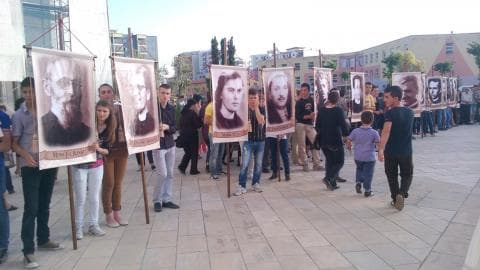On July 13, 2016, Albania’s bishops (all nine of them) received a decree from Pope Francis announcing the conclusion of the canonical process that recognized “the testimony of martyrdom to faith and country” of 38 Albanian martyrs, including 37 men and one woman, Maria Tuci.
The news was relayed by the Archbishop of Shkodër, Angelo Massafra, president of the Albania’s Bishops Conference, who considers it “a historical moment for the Church and the nation.” The beatification ceremony for Albania’s 38 martyrs, executed brutally by the Communist regime from 1945-1974, will be held in the city of Shkodër, northwestern Albania, on November 5, 2016.
The beatification will come fifteen days before the conclusion of the pope’s Holy Year of Mercy and two months after the canonization of Mother Teresa (September 4), who’s also a celebrated daughter of the Albanian nation. The new martyrs are from a marginal country with a Muslim majority, as Catholics make up less than 15 percent of the Albanian population.
Modern women martyrs like Maria Tuci, coming from a tiny country in the Balkans, who paid the ultimate price for their faith, have the power and the charisma to inspire and transform lives by their examples.
They embody what St. John Paul II calls the “genius of women” in his 1995 Letter to Women.
During his 2014 visit to Albania, Pope Francis touched upon, and was touched by, Albania’s commitment and testimony to faith. It was a short trip from Rome, to a land and a people who’ve been marginal and marginalized.
Albania is in Europe but not of Europe, its people have been tried and martyred, but they’ve also demonstrated great courage and fidelity in the profession of the faith.
“Recalling the decades of atrocious suffering and harsh persecution against Catholics, Orthodox and Muslims, we can say that Albania was a land of martyrs: many bishops, priests, men and women religious, and laity paid for their fidelity with their lives,” said Pope Francis during Mass at Mother Teresa Square.
So resilient and significant is the memory of the martyrs in Albanian history and people’s consciousness that the most prominent and the busiest boulevard in the capital city, Tirana, is named after them: “Boulevard of the Martyrs of the Nation” (Bulevardi Dëshmorët e Kombit).
In the New Testament, the theme of imitating Christ in his suffering and death is connected with suffering under earthly masters. Suffering for faith under Communist persecutors followed what St. Peter determined to be by extension the vocation of every Christian – to imitate Christ.
“For to this you have been called, because Christ also suffered for you, leaving you an example that you should follow in his footsteps,” it says in the New Testament’s first letter of Peter.
Moreover, St. Augustine taught his people that the martyrs were martyrs because they bore witness, not because they offered themselves in sacrifice. On the feast day of the Scillitan martyrs – twelve North African Christians executed for their beliefs on July 17, 180 – St. Augustine opened his sermon by teaching his congregation about the deep significance of martyrdom.
He said, “The day of this feast exhorts concerning the martyrs of Christ, that is the witnesses of Christ who were not embarrassed to confess His name before men.”
In this same sermon, St. Augustine continues to define martyrdom: “’Martyrs,’ the word is Greek, are called ‘witnesses’ (testes) in Latin. Therefore the holy martyrs, not false witnesses but true ones, brought forward a witness with their blood that there is another life preferable to this life, because they bravely scorned the passing one.”
Among Albania’s 38 martyrs on the way to beatification is a onetime postulant of the Stigmatine Sisters of Shkodër, Maria Tuci (1928-1950).
Arrested in 1949 when she was teaching at an elementary school run by the sisters, Maria died a martyr’s death the following year at the age of 22. In prison, she was brutally tortured for her faith and religious vocation, humiliated and sexually assaulted by the prison guards.
She was threatened by one of the guards in these terms: “I will reduce you to a state that even your family members would not be able to recognize you.” In fact, that’s exactly what happened.
Resisting to the end, she was closed in a tied sack with a street cat whom the guards beat continuously with a stick. Maria was brutally scratched and bitten by the cat’s pointy teeth. Puncture wounds from cat bites are usually very deep, sending bacteria deep into flesh, and if not immediately cured the infection can be lethal.
After days of brutal torture, Maria was admitted to the hospital, disfigured with bumps and blisters all over her body. She died an agonizing death on October 24, 1950, holding a rosary in her hands.
“I thank God because he gave me the force to die free,” she said.
Despite terrible torture, the 22-year-old did not betray her faith and personal dignity. She forgave her tormentors and the prison guards.
In effect, Tucci is “the modern St. Agnes, who forgave the persecutors and desired for reconciliation between victims and perpetrators” said Massafra in an interview with La Stampa/Vatican Insider.
Young Maria had the gifts of faith, fortitude, wisdom, love and forgiveness.
“Of all virtuous acts, martyrdom is the greatest proof of the perfection of charity,” explains St. Thomas Aquinas, and Maria demonstrated all these in her short life and her ultimate sacrifice.
The Church needs women of fortitude like Maria. In a culture of disbelief and doubt, Maria’s martyrdom and faith retain the power to inflame and transform hearts.
Women such as Mother Teresa and Maria Tuci make a strong case to revive the call to holiness. Their lives were perfect models of feminine holiness.
















